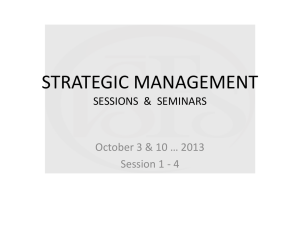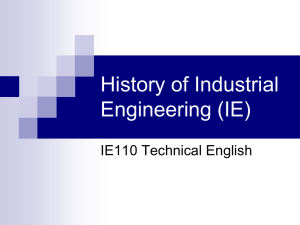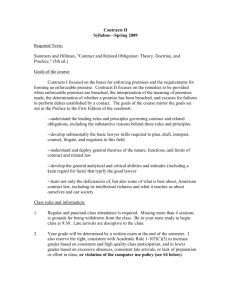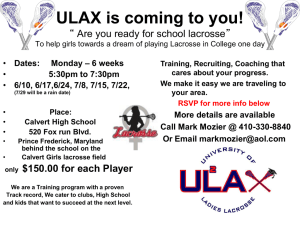A Survey of Corporate Diversity Practices of the S&P 100
advertisement
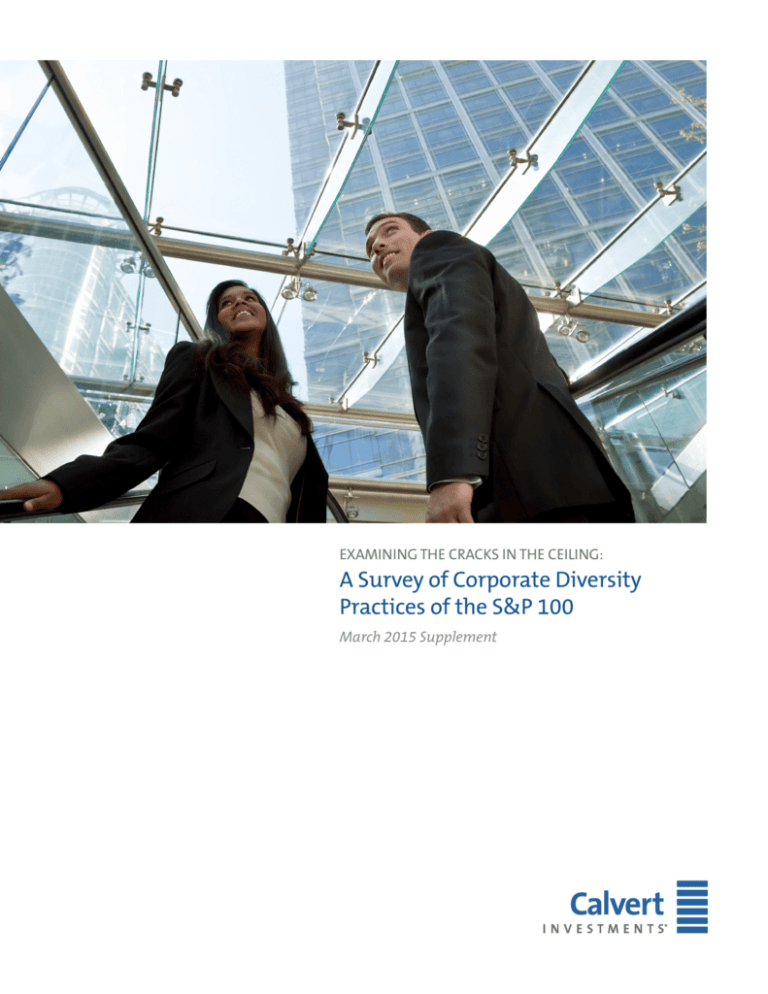
EXAMINING THE CRACKS IN THE CEILING: A Survey of Corporate Diversity Practices of the S&P 100 March 2015 Supplement EXAMINING THE CRACKS IN THE CEILING: A Survey of Corporate Diversity Practices of the S&P 100 We congratulate our 2014 diversity leaders: Bristol-Myers Squibb, Citigroup, Dow Chemical, Eli Lilly, Lockheed Martin, Merck, Microsoft, PepsiCo, Target and Wells Fargo. We appreciate the range of diversity efforts underway at these companies and challenge their industry peers to follow the examples they have set around inclusion practices and disclosure. This supplement to Calvert’s Examining the Cracks in the Ceiling series follows the ten-year anniversary of the Calvert Women’s Principles® (CWP). The CWP is the first global code of corporate conduct focused exclusively on empowering, advancing, and investing in women worldwide. The CWP and our diversity research are inextricably linked. Each plays a key role in elevating the level of dialogue and action around diversity as a whole—across gender and gender identity, sexual orientation, race and ethnicity, and physical ability—within America’s largest and most influential companies. Calvert continues to assess the diversity practices of the largely multinational companies that make up the Standard & Poor’s 100 Index (S&P 100). Using an in-depth methodology, we examine these companies’ diversity policies, programs, and performance; identify the leaders and laggards; and provide recommendations to help companies identify and remedy operational gaps. Calvert believes companies that fully commit to providing a fair and equitable working environment will recognize gains in both the workplace and marketplace. How We Rate Companies Using a 10-point system, Calvert assigns point values to companies based on their performance on 10 diversity indicators. These indicators encompass diversity policies, initiatives, performance, and disclosure. This allows us to quantify the degree to which each company demonstrates best practices across all 10 indicators.1 Calvert-generated diversity scores are based on publicly available information from company websites and sustainability reports, SEC filings, and outside publications such as Diversity Inc., Working Mother magazine, and the Human Rights Campaign Corporate Equality Index. Our reliance on public disclosure of diversity practices prevents us from capturing every nuance of a company’s particular approach to diversity, and our ratings should be reviewed with this constraint in mind. Our findings reflect company performance as disclosed between June and August 2014. As part of our research process, Calvert contacted all S&P 100 companies and provided them an opportunity to update and confirm the data we collected. Our response rate was 66%, with an additional 4% of companies providing supplementary public resources. For 34% of companies, our diversity ratings are based solely on our review of their public disclosures and external statements regarding their diversity programs. In 2014, Calvert incorporated a new controversy assessment into its methodology.2 While corporate controversies have always been an important consideration in our analysis of a company’s diversity performance, we have now explicitly integrated the impact of adverse events such as discrimination lawsuits and investigations into our assessment. Controversy scores were determined by factors such as the severity and persistence of adverse events and corporate responsiveness. Diversity performance is only part of a company’s overall corporate responsibility and sustainability profile. Calvert acknowledges that some companies that receive a top diversity ranking do not rank highly on other key issues. Calvert’s diversity ratings are not intended to reflect a comprehensive assessment of each S&P 100 company’s overall corporate responsibility and sustainability performance. 1. A score of zero points indicates there is no evidence of relevant company activity for that indicator. 2. Calvert referenced MSCI and Sustainalytics data to identify corporate controversies, which were assessed and coded to arrive at an independent controversy score. 2 DIVERSITY REPORT SUPPLEMENT 2015 DISCLOSURE A CRITICAL LINK Examples: Our analysis in 2014 underscores the wide variance in company disclosure on matters of diversity. Microsoft Colgate-Palmolive Mastercard 1. Diversity fully embraced and successfully implemented: These top companies disclose strong diversity programs and robust performance metrics that demonstrate both a commitment to, and progression towards, a fully inclusive workplace. (Score 85–100 points) Examples: 2. Strong programs and policies in place: The majority of these companies consider workplace diversity a contributor to overall corporate success, and disclose inclusion as an element of a broader corporate responsibility strategy. However, some in this cohort may lack strong diversity performance in the areas of executive and board representation, or may not adequately disclose performance metrics that indicate the success of their diversity strategies. (Score 55–80 points) Caterpillar EMC Cisco Systems Examples: Gilead Sciences National Oilwell Varco Twenty-First Century Fox 3. Diversity treated as a compliance matter: Some companies view diversity as an internal, human resources issue and fall short of fully integrating diversity practices across their operations. We find that these companies generally do not exhibit diverse leadership, and fail to provide sufficient public data on inclusion efforts, which makes assessment and accountability a challenge. (Score 5-50 points) DIVERSITY REPORT SUPPLEMENT 2015 3 1. EQUAL EMPLOYMENT OPPORTUNITY (EEO) POLICY POINT VALUE DIVERSITY CRITERIA S&P 100 COMPANIES 0 Company includes neither sexual orientation nor gender identity and/or expression 2010 2012 2014 5 Company includes sexual orientation 2010 2012 2014 Company includes sexual orientation AND gender identity and/or expression 2010 2012 2014 10 3 4 5 23 19 5 74 77 90 In 2014, 90 companies in the S&P 100 had EEO policies inclusive of sexual orientation and gender identity and/or expression; a 17% increase from 2012. Equal Employment Opportunity (EEO) Policy measures the extent to which a company institutionalizes equal opportunity for its LGBT workforce. While companies are legally mandated to protect employees on the basis of characteristics such as gender and race, they are not federally required to do so for sexual orientation and gender identity/expression. Research indicates that LGBT-supportive workplace policies are correlated with improved health outcomes, greater job satisfaction and commitment, and productivity.3 Moreover, these policies help bolster a company’s image as a fair and equitable employer, contributing to greater long-term shareholder value. 2. INTERNAL DIVERSITY INITIATIVES POINT VALUE DIVERSITY CRITERIA S&P 100 COMPANIES 0 No evidence of internal initiatives 2010 2012 2014 5 Evidence of one or two elements: mandatory training, leadership development, mentoring, or ERG programs 2010 2012 2014 Evidence of three or four elements: mandatory training, leadership development, mentoring, or ERG programs 2010 2012 2014 10 Internal Diversity Initiatives measures the extent to which companies offer programs that target and develop women and underrepresented groups, and encourage their movement up the corporate ladder. Because this indicator focuses largely on internal programs, Calvert’s scoring and evaluation depends significantly on what information companies make publicly available. 4 5 4 12 18 17 77 79 84 mentoring and/or employee resource groups (ERG), while 17 offer programs that include only one or two of these elements. Overall, four companies offer no evidence of internal diversity initiatives. Breakdown of Internal Diversity Initiatives ■■91 companies offer diversity training ■■54 companies have mandatory diversity training ■■90 companies have management/leadership development Within the S&P 100, 79 companies have implemented a comprehensive array of internal diversity initiatives that incorporate mandatory training, leadership development, training ■■76 have mentoring programs ■■89 have employee resource groups Compared with 2010 data, 20% more companies now sponsor employee resource groups. 3. The Williams Institute, “The Business Impact of LGBT-Supportive Workplace Policies”, May 2013. 4 DIVERSITY REPORT SUPPLEMENT 2015 3.EXTERNAL DIVERSITY INITIATIVES POINT VALUE DIVERSITY CRITERIA S&P 100 COMPANIES 0 No evidence of external initiatives 2010 2012 2014 5 Evidence of recruitment/outreach OR supplier diversity program 2010 2012 2014 10 Evidence of recruitment/outreach AND supplier diversity program 2010 2012 2014 External Diversity Initiatives assesses what strategies are employed to recruit from diverse groups, and to form mutually beneficial relationships with women and minorityowned businesses. The number of S&P 100 companies engaging diverse groups in recruitment and outreach efforts increased by four percent 7 7 5 13 10 10 80 83 85 since 2012. A majority of S&P 100 companies have established supplier diversity programs, demonstrating their understanding that procurement from minority and women-owned businesses can widen their presence among consumers, and expose new market opportunities. Moreover, these companies appreciate that responding to the demands of an increasingly diverse consumer base can engender innovation. 4. SCOPE OF DIVERSITY INITIATIVES POINT VALUE DIVERSITY CRITERIA S&P 100 COMPANIES 0 No reference to LGBT, disability, race/ethnicity, and/or gender ERGs 2010 2012 2014 19 15 18 5 ERG includes one or two: LGBT, disability, race/ethnicity, gender 2010 2012 2014 14 15 Specific to three or four LGBT, disability, race/ethnicity, gender 2010 2012 2014 10 Scope of Diversity Initiatives measures the breadth of corporate diversity strategies by group. These include: LGBT, disabled, ethnicity, and gender. While LGBT-supportive policies and programs have become more prevalent, initiatives for persons with disabilities continue to lag behind other groups. Ninety-five companies in the S&P 100 have instituted EEO policies. The number of companies 9 67 70 73 adopting domestic-partner benefits has risen by 11% since 2012, and the number of companies incorporating sexual orientation and gender identity/expression in their EEO policies has risen by 17%. Seventy-three percent of S&P 100 companies offer employee resource groups for LGBT employees, 77% offer groups for racial and ethnic minorities, and 81% offer them for women. In contrast, only 57% of companies offer employee resource groups for persons with disabilities. DIVERSITY REPORT SUPPLEMENT 2015 5 5. FAMILY-FRIENDLY BENEFITS POINT VALUE DIVERSITY CRITERIA S&P 100 COMPANIES 0 No evidence of family-friendly benefits 2010 2012 2014 5 One or two of the following benefits: flex-work, adoption assistance, dependent care, domestic-partner benefits 2010 2012 2014 10 Three or four of the following benefits: flex-work, adoption assistance, dependent care, domestic-partner benefits 2010 2012 2014 Family-Friendly Benefits measures the number of corporate programs designed to accommodate working families and the changing structures of contemporary households. This indicator measures flex-work, adoption assistance, dependent-care, and domestic-partner benefits. 7 9 6 8 16 22 71 75 86 In 2014, family-friendly benefits were offered by 94% of companies. The most common family-friendly benefit continues to be domestic-partner benefits, with 89 companies offering these to their employees. Eighty-one percent of S&P 100 companies offer flexible work schedules. 6. EEO-1 DISCLOSURE POINT VALUE DIVERSITY CRITERIA 0 Companies with no EEO-1 disclosure 2010 2012 2014 5 Companies with partial EEO-1 disclosure 2010 2012 2014 Companies with full EEO-1 disclosure 2010 2012 2014 10 EEO-1 Disclosure examines the public availability of demographic data across all corporate ranks. Since 2012, 11 more companies have fully disclosed EEO-1 data. The information technology sector accounts for more than onethird of this growth. However, S&P 100 companies have made 6 S&P 100 COMPANIES DIVERSITY REPORT SUPPLEMENT 2015 37 32 39 55 54 50 8 7 18 the least progress overall on this important indicator over time. Thirty-two companies in the S&P 100 still do not disclose any EEO-1 data, making it difficult to determine the effectiveness of corporate diversity initiatives toward the recruitment, retention, and advancement of women and minorities. 7. HIGHEST-PAID EXECUTIVES POINT VALUE RATINGS INDICATORS S&P 100 COMPANIES 0 No women or minorities among the five highest-paid executives 2010 2012 2014 5 One woman or minority among the five highest-paid executives 2010 2012 2014 Two or more women and/or minorities among the five highest-paid executives 2010 2012 2014 10 44 30 28 56 54 37 14 18 19 Note: Calvert identified an error in the results for “Highest-Paid Executives” (Diversity Indicator #7) as reported in the 2013 edition of this report (which presents data collected in 2012). In the 2013 edition, we incorrectly reported that 56 companies scored 0 points; 32 companies scored 5 points and 16 companies scored 10 points on this indicator. The chart above reflects the correct data. Highest-Paid Executives evaluates the diversity of a company’s five highest-paid executive officers, to measure the presence of women and minorities in the senior ranks. Over the past two years, we have seen only minimal progress in the number of women and minorities advancing to the executive ranks of S&P 100 companies. In fact, nearly half (44%) of the largest corporations in the United States still do not have any women or minorities in their five highest-paid positions. While women made up 21% of S&P 100 board director positions, they held only only about 9% of those companies’ highest paid positions in 2014. The percentage of minorities in the highestpaid positions was even lower, at 8%. The number of companies that include at least one woman among their five highest-paid executives increased by 19% since 2012. 8. BOARD REPRESENTATION POINT VALUE DIVERSITY CRITERIA S&P 100 COMPANIES 0 No women or minorities on board of directors 2010 2012 2014 5 One or two women and/or minorities on board of directors 2010 2012 2014 Three or more women and/or minorities on board of directors 2010 2012 2014 10 Board Representation assesses women and minority representation in the boardroom. Calvert believes that a critical mass of diverse directors is vital for sound corporate decisionmaking and well-rounded market perspectives. 0 3 2 17 30 27 67 71 83 While women and minorities are being elected to corporate boards in greater numbers, they remain underrepresented in board leadership roles. Thirty-three percent of S&P 100 companies lack female committee chairs, and 52% lack minority committee chairs. In 2014, every company in the S&P 100 had at least one woman on its board of directors, and 90% of S&P 100 boards elected at least one minority. DIVERSITY REPORT SUPPLEMENT 2015 7 9. DIRECTOR SELECTION CRITERIA POINT VALUE DIVERSITY CRITERIA S&P 100 COMPANIES 0 Limited/no mention of diversity 2010 2012 2014 5 General mention of diversity 2010 2012 2014 Specific mention of diversity by race and/or gender 2010 2012 2014 10 Director Selection Criteria reflects the evaluation of a company’s guidelines for director nominations, to assess whether they routinely seek women and minorities as board candidates. In 2014, while all S&P 100 boards had at least one woman director and most had minority representation, nearly half still lacked sufficient disclosure of a director selection policy that formally includes gender and race among their diversity criteria. 22 10 31 25 27 32 44 51 58 Our survey also revealed that 76 companies have at least one woman on those board committees responsible for the selection of new directors and for steering overall board composition; women are the appointed chairs for 23 of these committees. The remaining 24 companies risk missing important perspectives that could enhance their overall board composition. 10. OVERALL CORPORATE COMMITMENT POINT VALUE RATINGS INDICATORS 0 No evidence of an overall corporate commitment to diversity 2010 2012 2014 5 Evidence of one or two corporate commitments 2010 2012 2014 Evidence of three or more corporate commitments 2010 2012 2014 10 Overall Corporate Commitment examines corporate structures that govern inclusion strategies across all operations. Here we look for board oversight of diversity programs, an established diversity council, CEO and/or chair involvement in inclusion initiatives, and compensation plans tied to diversity objectives. Top-down diversity commitments were on the rise in 2014. Companies in the S&P 100 increasingly acknowledge the value of integrating diversity objectives into their corporate 8 S&P 100 COMPANIES DIVERSITY REPORT SUPPLEMENT 2015 11 16 19 28 39 46 38 42 61 strategies and structures. In the past two years, top scores in overall corporate commitment increased by 19 companies (a 45% change from 2012.) This stems primarily from greater board oversight of diversity initiatives and increased CEO and/or chair involvement. Companies that scored well on this indicator tended to score higher than their industry peers overall. Threequarters of companies that scored a perfect 10 on the corporate commitment indicator have total scores which exceed their sector average. Conclusions and Recommendations SCORE DISTRIBUTION 2010–2014* 25 2010 2012 2014 Number of Companies 20 15 10 5 0 0 5 10 15 20 25 30 35 40 45 50 55 Overall Score — Points 60 65 70 75 80 85 90 95 100 *Does not include controversy assessment While no companies arrived at a perfect score of 100 this year, the number of companies that received a top score of 95 has increased since 2012. identify areas of opportunity and risk, and in turn set manageable and measurable goals for improvement. 2014 AVERAGE SECTOR SCORES 2010 2012 2014 80 60 40 POINT VALUE RATINGS INDICATORS Utilities Materials Information Technology Industrials Healthcare S&P 100 COMPANIES 0 Limited/no exposure to diversity controversies 2014 -5 Moderate exposure to diversity controversies 2014 5 -10 Significant exposure to diversity controversies 2014 5 Calvert also examined the existence, severity, and persistence of adverse events such as discrimination investigations and lawsuits; and assessed corporate responsiveness. From this analysis, we applied an additional score ranging from 0 to -10, to a company’s total indicator score. Telecommunication Services ADDITIONAL ANALYSIS: DIVERSITY CONTROVERSIES Financials 0 Energy 20 Consumer Staples The S&P 100 has improved diversity commitments overall since 2012. To ensure continued progress, greater accountability and disclosure is essential. We encourage companies to use this report as a benchmarking tool to 100 Consumer Discretionary The S&P 100 Index consists of companies in 10 sectors, but they are not evenly distributed. The healthcare sector, which is a demonstrated leader in diversity initiatives and performance in 2014, makes up 13.6% of the S&P 100, while the energy sector, which scored lowest according to our analysis, comprises 10.3% of the Index. 90 This is reflected in the downward scoring shift for 10 companies experiencing moderate to severe controversies. These findings indicate potential diversity policy and program implementation challenges. We urge companies with diversity controversy exposure to critically assess their diversity policies and programs and commit to continued improvement. A small subset of companies, despite having strong diversity policies and programs, had notable exposure to adverse events. DIVERSITY REPORT SUPPLEMENT 2015 9 2014 SCORE DISTRIBUTION AND CONTROVERSY ASSESSMENT 25 Ten Indicators Ten Indicators with Controversy Assessment Number of Companies 20 15 10 5 0 0 5 10 15 20 25 30 35 40 45 50 55 Overall Score — Points We applaud companies’ growing dedication in 2014 to women and minority employees, momentum around family-friendly work environments, and accelerated progress in support of LGBT employees. Looking ahead, we hope to see greater movement toward enhanced corporate diversity commitments reflected in inclusive director selection criteria. Relatedly, we also hope to see greater representation of women and minorities in the boardroom and at the executive level, two areas which are progressing at a glacial pace, despite investor interest. Other areas for improvement include EEO-1 disclosure, and an expanded overall scope of diversity initiatives, with particular attention to persons with disabilities. 60 65 70 75 80 85 90 95 100 of strength and weakness. We also encourage companies to evaluate their gender-specific strategies using a web-based assessment tool created by the Gender Equality Principles Initiative (a coalition of the City of San Francisco’s Department on the Status of Women, Verité, and Calvert), available at www.genderprinciples.org. Adopting and implementing comprehensive corporate diversity initiatives most often entails gradual, but significant changes. Accordingly, we offer three key recommendations to help companies improve their diversity rating: Increase disclosure and accessibility of diversity data. Key stakeholders, including employees, investors, and consumers, seek assurance that inclusion and diversity exist at all company levels, and that corporate leadership is approaching diversity challenges transparently and innovatively. Increasingly, companies are willing to make publicly available a range of sustainability metrics such as their carbon footprint or safety performance. In the coming years, we hope to see companies place the same emphasis on accountability as it relates to diversity data. Conduct a self-assessment. Using Calvert’s 10 key indicators and report methodology as a roadmap, companies should examine their current policies and programs to identify areas Support public policy and cultivate relationships with diverse communities. Companies should extend their diversity efforts beyond their immediate workplaces and into the 2014 DIVERSITY LEADERS Calvert congratulates the 10 S&P 100 companies that achieved a top score of 95 points overall: Bristol-Myers Squibb Citigroup Dow Chemical Eli Lilly Lockheed Martin Merck Microsoft PepsiCo Target Wells Fargo Most Improved S&P 100 Companies The following companies have improved their overall diversity score by 50 points since our first report in 2010: Philip Morris International, Schlumberger, and Occidental Petroleum. 10 DIVERSITY REPORT SUPPLEMENT 2015 communities in which they operate. We encourage companies to endorse public policy measures that support their diverse workforces. Corporate spending also has implications for diversity performance and presents opportunities for community engagement. Procurement from a diverse set of suppliers, including women and minority-owned businesses, can spur opportunities for innovation and growth. Companies should also consider the ways in which their philanthropic activities reflect their broader diversity goals. Supporting organizations which benefit women and minorities can complement outreach and recruitment efforts. While this supplement examines the diversity practices of the S&P 100, Calvert believes that all companies must responsibly manage their impact in a variety of areas, including governance and ethics, environment, workplace, product safety and impact, human rights, and community relations. DIVERSITY REPORT SUPPLEMENT 2015 11 Final Rankings by Score (includes controversy assessment) COMPANY PTS COMPANY PTS COMPANY PTS COMPANY PTS Bristol-Myers Squibb 95 Pfizer Inc. 90 Metlife Inc. 80 Honeywell Intl Inc. 70 Citigroup Inc. 95 Abbott Laboratories 85 Schlumberger Ltd 80 Starbucks Corp 70 Dow Chemical 95 Allstate Corp 85 Southern Co 80 Union Pacific Corp 70 Lilly Eli & Co 95 Baxter Intl Inc. 85 Walgreen Co 80 United Technologies Corp 70 Lockheed Martin 95 Colgate-Palmolive Co 85 General Motors Company 80 Unitedhealth Group Inc. 70 Merck & Co Inc. 95 Goldman Sachs Group Inc. 85 Exxon Mobil Corp 75 Apache Corp 65 Microsoft Corp 95 Google Inc. 85 Ford Motor Co 75 Philip Morris International 65 PepsiCo Inc. 95 Home Depot Inc. 85 Altria Group Inc. 75 Raytheon Co 65 Target Corp 95 Mastercard Inc. 85 Amgen Inc. 75 Boeing Co 60 Wells Fargo & Co 95 McDonald's Corp 85 Bank of America Corp 75 Emerson Electric Co 60 3M Co 90 Monsanto Co. 85 Cisco Systems Inc. 75 Norfolk Southern Corp 55 AbbVie Inc. 90 Procter & Gamble 85 E. I. du Pont de Nemours and Company 75 Apple Inc. 55 Accenture plc 90 The Bank of New York Mellon Corp 85 QUALCOMM Inc. 75 Freeport McMoRan Copper & Gold 55 American Express Co 90 US Bancorp 85 Texas Instruments Inc. 75 Facebook Inc. 55 Chevron Corp 90 Walt Disney Co 85 Time Warner Inc. 75 Costco Wholesale Corp 50 Coca-Cola Co 90 Wal-Mart Stores 85 United Parcel Service Inc. 75 Mondelez International Inc. 50 Comcast Corp 90 AT&T Inc. 80 Verizon Communications Inc. 75 Amazon.com Inc. 45 Hewlett-Packard Co 90 Biogen Idec Inc. 80 Visa Inc. 75 Anadarko Petroleum Corp 45 Intel Corp 90 CVS Caremark Corp. (now CVS Health) 80 American Intl Group Inc. 70 General Dynamics 45 Johnson & Johnson 90 Exelon Corp 80 Capital One Financial 70 Devon Energy Corp 40 JP Morgan Chase & Co 90 FedEx Corp 80 Caterpillar Inc. 70 Gilead Sciences Inc. 35 Morgan Stanley 90 General Electric Co 80 ConocoPhillips 70 Simon Property Group 25 NIKE Inc. 90 Intl Business Machines Corp 80 eBay Inc. 70 National Oilwell Varco Inc. 20 Occidental Petroleum 90 Lowe's Cos Inc. 80 EMC Corp 70 Twenty-First Century Fox, Inc. 20 Oracle Corp 90 Medtronic Inc. 80 Halliburton Co 70 Berkshire Hathaway 5 12 DIVERSITY REPORT SUPPLEMENT 2015 Final Rankings by Alpha Order (includes controversy assessment) COMPANY PTS COMPANY PTS COMPANY PTS COMPANY PTS 3M Co 90 Coca-Cola Co 90 Hewlett-Packard Co 90 Pfizer Inc. 90 Abbott Laboratories 85 Colgate-Palmolive Co 85 Home Depot Inc. 85 Philip Morris International 65 AbbVie Inc. 90 Comcast Corp 90 Honeywell Intl Inc. 70 Procter & Gamble 85 Accenture plc 90 ConocoPhillips 70 Intel Corp 90 QUALCOMM Inc. 75 Allstate Corp 85 Costco Wholesale Corp 50 Intl Business Machines Corp 80 Raytheon Co 65 Altria Group Inc. 75 CVS Caremark Corp. (now CVS Health) 80 Johnson & Johnson 90 Schlumberger Ltd 80 Amazon.com Inc. 45 Devon Energy Corp 40 JP Morgan Chase & Co 90 Simon Property Group 25 American Express Co 90 Dow Chemical 95 Lilly Eli & Co 95 Southern Co 80 American Intl Group Inc. 70 E. I. du Pont de Nemours and Company 75 Lockheed Martin 95 Starbucks Corp 70 Amgen Inc. 75 eBay Inc. 70 Lowe's Cos Inc. 80 Target Corp 95 Anadarko Petroleum Corp 45 EMC Corp 70 Mastercard Inc. 85 Texas Instruments Inc. 75 Apache Corp 65 Emerson Electric Co 60 McDonald's Corp 85 The Bank of New York Mellon Corp 85 Apple Inc. 55 Exelon Corp 80 Medtronic Inc. 80 Time Warner Inc. 75 AT&T Inc. 80 Exxon Mobil Corp 75 Merck & Co Inc. 95 Twenty-First Century Fox, Inc. 20 Bank of America Corp 75 Facebook Inc. 55 Metlife Inc. 80 Union Pacific Corp 70 Baxter Intl Inc. 85 FedEx Corp 80 Microsoft Corp 95 United Parcel Service Inc. 75 Berkshire Hathaway 5 Ford Motor Co 75 Mondelez International Inc. 50 United Technologies Corp 70 Biogen Idec Inc. 80 Freeport McMoRan Copper & Gold 55 Monsanto Co. 85 Unitedhealth Group Inc. 70 Boeing Co 60 General Dynamics 45 Morgan Stanley 90 US Bancorp 85 Bristol-Myers Squibb 95 General Electric Co 80 National Oilwell Varco Inc. 20 Verizon Communications Inc. 75 Capital One Financial 70 General Motors Company 80 NIKE Inc. 90 Visa Inc. 75 Caterpillar Inc. 70 Gilead Sciences Inc. 35 Norfolk Southern Corp 55 Walgreen Co 80 Chevron Corp 90 Goldman Sachs Group Inc. 85 Occidental Petroleum 90 Wal-Mart Stores 85 Cisco Systems Inc. 75 Google Inc. 85 Oracle Corp 90 Walt Disney Co 85 Citigroup Inc. 95 Halliburton Co 70 PepsiCo Inc. 95 Wells Fargo & Co 95 DIVERSITY REPORT SUPPLEMENT 2015 13 About Calvert Investments A global leader in responsible investing, Calvert Investments is a diversified investment management firm that provides mutual funds and separate accounts to institutional investors, retirement plans, financial intermediaries and their clients. We offer a broad array of equity, fixed income, and multi-asset investment strategies that feature integrated environmental, social, and governance research and corporate engagement. Founded in 1976 and based in Bethesda, Maryland, Calvert Investments managed assets of more than $13.0 billion as of March 31, 2015. For more information call Calvert at 800.368.2748 or visit www.calvert.com. All views and opinions expressed are being presented for informational and educational purposes only, represent the views and opinions of the author(s) as of the date of the writing and are subject to change without notice. These views and opinions are not intended to forecast future events or guarantee future results and do not constitute a recommendation or a solicitation to buy or sell any security. This information does not take into account the specific investment objective, financial situation, or specific needs of any individual, does not provide information reasonably sufficient upon which to base an investment decision and should not be relied upon as investment advice. This information has been obtained from sources believed to be reliable, but Calvert makes no representation as to its accuracy or completeness. Calvert Investments is a registered trade name representing Calvert Investments, Inc. and its subsidiaries, including Calvert Investment Management, Inc., an SEC-registered investment adviser, and Calvert Investment Distributors, Inc., a FINRA member broker/dealer and distributor of the Calvert mutual funds. BR10063-201503 14 DIVERSITY REPORT SUPPLEMENT 2015


